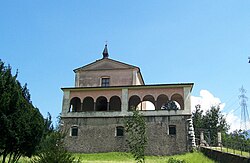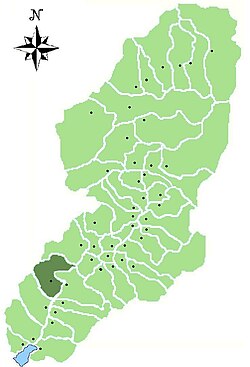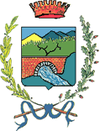Angolo Terme
|
Angolo Terme Angól |
||
|---|---|---|
| Comune | ||
| Comune di Angolo Terme | ||

Church of San Silvestro
|
||
|
||
 |
||
| Location of Angolo Terme in Italy | ||
| Coordinates: 45°53′32″N 10°8′55″E / 45.89222°N 10.14861°E | ||
| Country | Italy | |
| Region | Lombardy | |
| Province / Metropolitan city | Brescia (BS) | |
| Frazioni | Anfurro, Mazzunno, Terzano | |
| Government | ||
| • Mayor | Riccardo Minini | |
| Area | ||
| • Total | 30 km2 (10 sq mi) | |
| Elevation | 426 m (1,398 ft) | |
| Population (31 December 2011) | ||
| • Total | 2,517 | |
| • Density | 84/km2 (220/sq mi) | |
| Demonym(s) | Angolesi | |
| Time zone | CET (UTC+1) | |
| • Summer (DST) | CEST (UTC+2) | |
| Postal code | 25040 | |
| Dialing code | 0364 | |
| Website | Official website | |
Angolo Terme (Angól in Camunian dialect) is a comune in Val Camonica, province of Brescia, in Lombardy, Italy. It lies on the right bank of the river Dezzo, in the lower Valle di Scalve.
Angolo was a mining center known since the 4th century BC. Since the 12th century AD its history was closely linked to that of the Federici family. In 1335 Luchino Visconti granted them a privilege to extract iron in the area. In 1403 Caterina Visconti gave the family the possessions of the Antonioli of Grevo in exchange for the support offered her.
In 1408 Angolo went to Pandolfo III Malatesta, who ceded it to Comicino Federici, who temporarily sided for the Guelphs, until 1419, when he returned to the Ghibelline allegiance and the Visconti.
In 1509 Angolo (called Anghol) appears in a map of the Valle Camonica designed by Leonardo da Vinci.
In 1846 the town of Angolo, placed administratively in the province of Bergamo, demanded to be included in the province of Brescia.
In 1923 several houses suffer damage from the failure of the Gleno Dam (Italy), with 46 deaths among the inhabitants.
The scütüm are in camunian dialect nicknames, sometimes personal, elsewhere showing the characteristic features of a community. The one which characterize the people of Angolo Terme is Treàangoi.
...
Wikipedia


